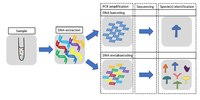
Photo from wikipedia
To understand trophic interactions and the precise ecological role of each predatory species, it is important to know which arthropod and plant resources are used by generalist predators in agroecosystems.… Click to show full abstract
To understand trophic interactions and the precise ecological role of each predatory species, it is important to know which arthropod and plant resources are used by generalist predators in agroecosystems. Molecular approaches, such as the use of high-throughput sequencing (HTS), play a key role in identifying these resources. This study develops a multi-primer metabarcoding approach for screening the most common trophic interactions of two predatory arthropods with contrasting morphologies, Rhagonycha fulva (Coleoptera: Cantharidae) and Anthocoris nemoralis (Hemiptera: Anthocoridae) collected from a peach crop. To reduce the time and cost of this metabarcoding approach, we first evaluated the effect of using two different predator-pools of different size (10 and 23 individuals of the same species). We also used our system to analyze the performance of one and two primer pairs in the same library. Our results show that the analysis of 23 individuals together with the use of two primer pairs in the same library optimize the HTS analysis. Using these best-performing conditions, we then analyzed the entire bodies of field-collected predators as well as the washing solutions used to clean the insect bodies. We were able to identify both gut content (i.e., diet) and external pollen load (i.e., on the insects' bodies). This study also demonstrates the importance of washing predatory insects' bodies prior to HTS analysis when the target species have a considerable size (>10 mm) and hairy structures. This metabarcoding approach has significant potential for the study of trophic links in agriculture, revealing expected and unexpected trophic relationships. This article is protected by copyright. All rights reserved.
Journal Title: Insect science
Year Published: 2021
Link to full text (if available)
Share on Social Media: Sign Up to like & get
recommendations!